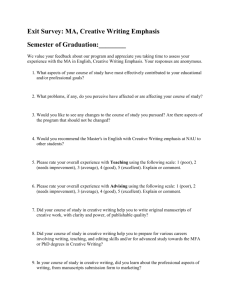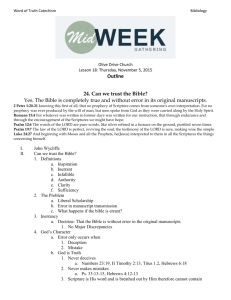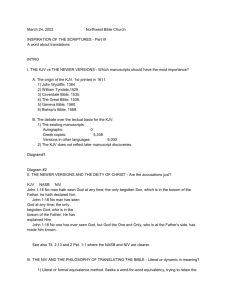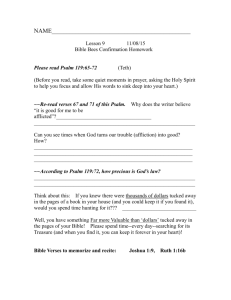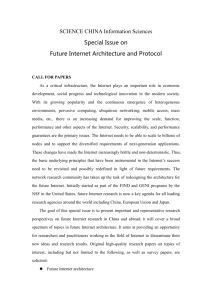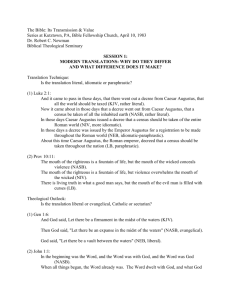BibleTrans-Value
advertisement
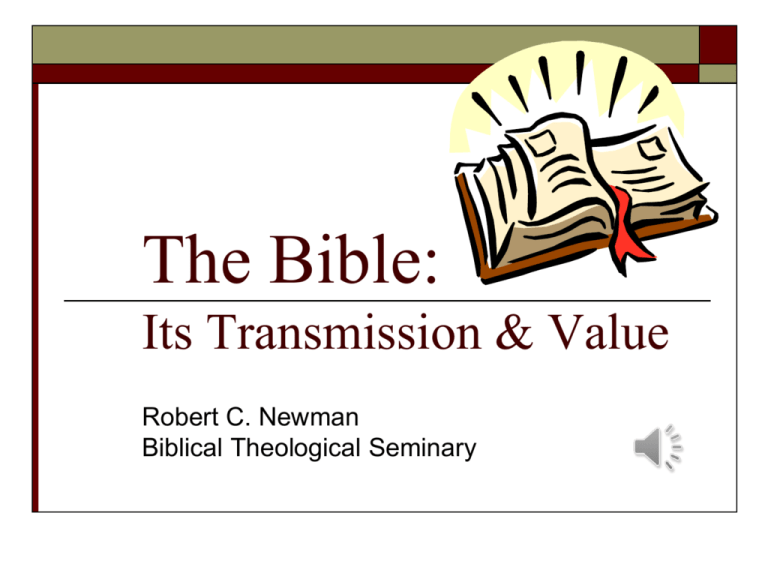
The Bible: Its Transmission & Value Robert C. Newman Biblical Theological Seminary Modern Translations: Why Do They Differ? What Difference Does It Make? Why Do They Differ? Translation Technique Theological Outlook Textual Basis Translation Technique Is the Translation … Literal? Idiomatic? Paraphrastic? Translation Technique Literal Idiomatic Paraphrastic Translation Technique Luke 2:1 And it came to pass in those days, that there went out a decree from Caesar Augustus, that all the world should be taxed (KJV, rather literal). Now it came about in those days that a decree went our from Caesar Augustus, that a census be taken of all the inhabited earth (NASB, even more literal). In those days Caesar Augustus issued a decree that a census should be taken of the entire Roman world (NEB, idiomatic/paraphrastic). About this time Caesar Augustus, the Roman emperor, decreed that a census should be taken throughout the nation (LB, paraphrastic). Translation Technique Proverbs 10:11 The mouth of the righteous is a fountain of life, but the mouth of the wicked conceals violence (NASB). The mouth of the righteous is a fountain of life, but violence overwhelms the mouth of the wicked (NIV). There is living truth in what a good man says, but the mouth of the evil man is filled with curses (LB). Theological Outlook Is the Translation … Liberal? Evangelical? Catholic? Sectarian? Theological Outlook Genesis 1:6 And God said, Let there be a firmament in the midst of the waters (KJV). Then God said, "Let there be an expanse in the midst of the waters" (NASB, evangelical). God said, "Let there be a vault between the waters" (NEB, liberal). Theological Outlook John 1:1 In the beginning was the Word, and the Word was with God, and the Word was God (NASB). When all things began, the Word already was. The Word dwelt with God, and what God was, the Word was (NEB). In the beginning the Word was, and the Word was with God, and the Word was a god (NWT, Jehovah’s Witnesses). Theological Outlook Matthew 16:18 … you are Peter, and upon this rock I will build my church (NASB, evangelical). … you are Peter, the Rock, and on this rock I will build my church (NEB, ecumenical). … you are "Rock," and on this rock I will build my church (NAB, Catholic). Theological Outlook Isaiah 9:6 And his name will be called Wonderful Counselor, Mighty God, Eternal Father, Prince of Peace (NASB, evangelical). And he shall be called in purpose wonderful, in battle Godlike, Father for all time, Prince of Peace (NEB, liberal). And his name is called Pele-joez-el-gibbor-Abi-ad-sarshalom (JPS, Jewish, w/ footnote "That is, Wonderful in counsel is God the mighty, the everlasting Father, the Ruler of Peace"). Theological Outlook Genesis 11:1 Now (the whole earth)… (NASB, evangelical). Once upon a time… (NEB, liberal). Hebrew is veyehi: "and it came to pass" Textual Basis Is the underlying Greek or Hebrew text based on… The Traditional Text? A Critical Text? A Conjecture? Textual Basis Traditional Text The text of the OT and NT as it existed in the majority of manuscripts that were known at the time the Bible first began to be printed (about AD 1500). This is the text used in the KJV, and modern versions such as the NKJV. Textual Basis Critical Text The text of the OT and NT as reconstructed from all presently-known manuscripts, giving greater weight to those manuscripts which are earlier and/or appear to be more reliable. This is used in most modern versions. See the marginal notes in the NASB or NIV for samples. Differences range from single words, to phrases, up to several verses. Textual Basis Conjecture Reconstructing some part of the text where the editor feels that none of the manuscripts existing today preserves the original reading. Extremely rare in the NT. In OT: Rarely done by conservatives More common with liberals Conjecture: Some Samples 1 Samuel 13:1 Saul reigned one year; and when he had reigned two years over Israel (NKJV). Saul was [forty] years old when he began to reign, and he reigned [thirty] two years over Israel (NASU). Conjecture: Some Samples Psalm 2:12 Do homage to the son (NASB, evangelical). Kiss the king (NEB, liberal). Bow down to him (GNB, liberal). Kiss his feet (RSV, liberal). Some Tests for a Theologically-Sound Translation Do the translators believe the apostles properly understood OT Scripture? Do the translators believe the apostles thought Jesus was God? Do the translators play down Messianic prophecy? Do the translators play down resurrection in the OT? Do the translators "correct" the text without manuscript support? The Hand-Copying of the Bible Can we have confidence in it? Hand-Copying of the Bible Error in Hand-Copying Causes of Error Correction of Error Estimation of Error Causes of Error Contrast machine printing with hand-copying: Independence of Copies Each hand-copy independent Value of Proofreading Have to proofread every copy Types of Error Accidental Changes Errors of Sight or Writing Confusion of letters Skipping Interchange Wrong word division Errors of Hearing Errors of Memory Errors of Judgment Types of Error Intentional Changes Attempted Corrections Grammatical Harmonization Combination Doctrinal Corrections In surviving manuscripts, generally toward "orthodoxy" Correction of Error Collation of Manuscripts Collect variants Study characteristics of individual manuscripts Internal Tests Context Style Harder reading Shorter reading Best explains others Correction of Error External Tests Best manuscript Best combinations Best family Estimation of Error Test growth of error during period we have manuscripts Compare KJV with NASB Compare Traditional Text with Codex Vaticanus Compare Medieval Hebrew manuscripts with the Dead Sea Scrolls. Estimation of Error Results No doctrines of Scripture depend upon any unsound text. Variations at most only involve whether a given doctrine is taught in a particular passage or not. The Earliest Manuscripts What do we have today? The Problem of Time As time passes, a manuscript suffers increasing damage from wear & tear, decay, and various other hazards. As a result, for virtually any ancient work, we are more likely to have fragments that have survived than complete copies. Let us look briefly at the situation for the manuscripts of the Old and New Testaments. New Testament Manuscripts The originals were probably written over the period AD 50 to 100. Our earliest fragment is a scrap from the Gospel of John, copied about AD 125, less than a generation after John wrote. The oldest nearly complete copy of a whole book (also John) comes from ~ AD 200. The oldest remaining complete copy of the whole NT dates from about AD 350. New Testament Manuscripts P52 – John Rylands papyrus of the Gospel of John, chapter 18, from the first third of the second century (AD 100-135). New Testament Manuscripts P66 – Papyrus Bodmer II, an almost complete copy of the Gospel of John, from about AD 200. New Testament Manuscripts Codex Sinaiticus – from ~AD 350 oldest complete manuscript of the NT; end of John’s Gospel. Old Testament Manuscripts The originals were probably written over the period 1400-400 BC. The earliest fragments discovered to date are among the Dead Sea Scrolls: parts of Exodus and Samuel from ~250 BC. The earliest complete book (Isaiah) comes from the same find, dating to ~125 BC. The earliest complete copy of the whole OT, surprisingly, is a Greek translation, from ~AD 350. The earliest complete Hebrew manuscript only goes back to about AD 950. Old Testament Manuscripts A fragment of Exodus from the Dead Sea Scrolls, dating to about 250 BC. Old Testament Manuscripts 1QIsaiaha – the earliest complete book ms of the OT, dating to ~125 BC, found in cave 1 at Qumran. Old Testament Manuscripts Codex Vaticanus – about AD 350, contains all of the OT in Greek except for a large part of Genesis and the Psalms added in the 15th century. Old Testament Manuscripts A portion of Codex Aleppo, the oldest known surviving complete manuscript of the OT in Hebrew, from ~AD 950. Comparison with Other Works Work New Testament ~75 Josephus ~90 Plutarch ~100 Tacitus ~100 ~ 350 ~1000 ~950 ~850 Old Testament 1400-400 Enuma Elish ~1750 BC Rigveda 1500-1000 Iliad bef 700 BC ~350 750-1750 ~650 BC ~1100 ~1350 AD ~2600 ~1050 AD 1750+ Originally Written Earliest Comp Ms Difference ~275 ~900 ~850 ~750 The Autographs What are they worth? The Bible’s Claims for Itself The ultimate author is God, the creator of the universe and the controller of history. 2 Timothy 3:16 Psalm 119:1, 89 Genesis 1:1 Proverbs 16:1, 9, 33 2 Timothy 3:16 2Tim 3:16 (NIV) All Scripture is God-breathed and is useful for teaching, rebuking, correcting and training in righteousness, Psalm 119:1, 89 Psalm 119:1 (NIV) Blessed are they whose ways are blameless, who walk according to the law of the LORD. Psalm 119:89 (NIV) Your word, O LORD, is eternal; it stands firm in the heavens. Genesis 1:1 Genesis 1:1 (NIV) In the beginning God created the heavens and the earth. Proverbs 16:1, 9, 33 Proverbs 16:1 (NIV) To man belong the plans of the heart, but from the LORD comes the reply of the tongue. Proverbs 16:9 (NIV) In his heart a man plans his course, but the LORD determines his steps. Proverbs 16:33 (NIV) The lot is cast into the lap, but its every decision is from the LORD. The Bible’s Claims for Itself The Bible’s contents give us what we need to know to solve our deepest problems and to transform us into happy, fulfilled, useful people. 2 Timothy 3:15-17 Psalm 119:1, 97-100, 105 Psalm 1:1-6 2 Timothy 3:15-17 2 Timothy 3:15-17 (NIV) and how from infancy you have known the holy Scriptures, which are able to make you wise for salvation through faith in Christ Jesus. 16 All Scripture is God-breathed and is useful for teaching, rebuking, correcting and training in righteousness, 17 so that the man of God may be thoroughly equipped for every good work. Psalm 119:1, 97-100, 105 Psalm 119:1 (NIV) Blessed are they whose ways are blameless, who walk according to the law of the LORD. Psalm 119:97-100 (NIV) Oh, how I love your law! I meditate on it all day long. 98 Your commands make me wiser than my enemies, for they are ever with me. 99 I have more insight than all my teachers, for I meditate on your statutes. 100 I have more understanding than the elders, for I obey your precepts. Psalm 119:105 (NIV) Your word is a lamp to my feet and a light for my path. Psalm 1:1-6 Psalm 1:1-6 (NIV) Blessed is the man who does not walk in the counsel of the wicked or stand in the way of sinners or sit in the seat of mockers. 2 But his delight is in the law of the LORD, and on his law he meditates day and night. 3 He is like a tree planted by streams of water, which yields its fruit in season and whose leaf does not wither. Whatever he does prospers. 4 Not so the wicked! They are like chaff that the wind blows away. 5 Therefore the wicked will not stand in the judgment, nor sinners in the assembly of the righteous. 6 For the LORD watches over the way of the righteous, but the way of the wicked will perish. The Bible’s Evidence for Itself Cosmology Biology Prophecy History Personal Experience Cosmology The Bible pictures a universe with an origin rather than an eternal universe. This universe was planned by the eternal God. This fits the data of cosmology as known today better than the alternatives. Biology An area of hot controversy today. The Bible pictures life and consciousness as having a nonnatural origin, though the exact nature of God's intervention may be disputed. Scientists seeking a naturalistic explanation for the origin of life & consciousness face the problem that randomness cannot produce the levels of order observed. Prophecy The Bible claims to be authored by the One who controls history, and it has many predictions of detailed events far in advance of their fulfillment. These include: The Messiah Israel Surrounding Nations History There is also evidence of supernatural intervention into history. The most striking examples involve the time of Moses and the ministry of Jesus. Occult phenomena also point to supernatural activity from the "other side." Personal Experience The history of Christianity is filled with examples of the transformation of individuals and societies by the influence of the Gospel. No other religions have produced a comparable effect, certainly not secular humanism. George Muller (1805-1898) Personal Experience Christianity has had a powerful influence on society, in those places where it has not been destroyed or badly perverted. Conclusions In spite of the great variety of Bible versions today, there are sound criteria for making choices. The evidence from textual study indicates that the Bible has been very carefully preserved from antiquity. We have good warrant for believing that we have essentially the Bible as it came from the hands of its authors. The Bible provides excellent evidence that its ultimate author is God. The End May we give ourselves to serious study of the Bible!
